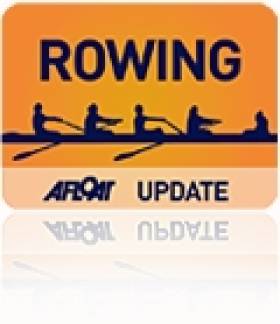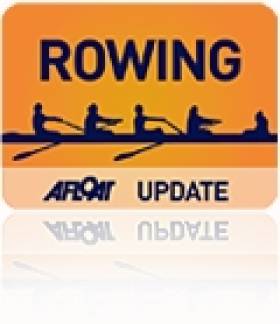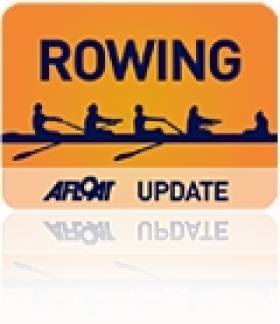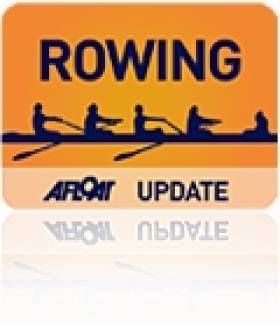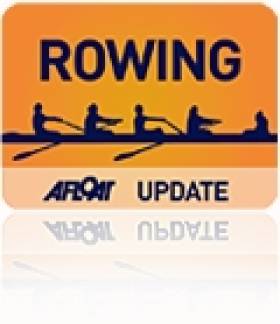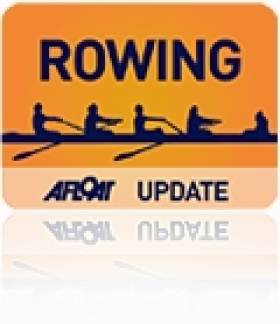Displaying items by tag: rowing
PODCAST: Relive the Best Race of the Champs
Mark O'Donovan of the Skibbereen quadruple tells the story of how the crew won the title at the National Championships. The crew of Richard Coakley, Gearoid Murphy, O'Donovan and Justin Ryan are the Afloat Rowers of the Month for September.
Skibbereen Quadruple Light Up September
The Afloat Rowers of the Month for September are the Skibbereen men’s senior quadruple of Richard Coakley, Gearoid Murphy, Mark O’Donovan and Justin Ryan. The crew won the best race of the National Championships, beating a UCD/St Michael’s composite by .4 of a second to take the title. It has been a terrific year for O’Donovan and Ryan on the international stage as well. They made up half of the Ireland quadruple which took silver at the World Under-23 Championships in Belarus in July.
Rower of the Month Awards: The judging panel is made up of Liam Gorman, rowing correspondent of The Irish Times, President of Rowing Ireland Anthony Dooley and David O'Brien, Editor of Afloat magazine. Monthly awards for achievements during the year will appear on afloat.ie and the overall national award will be presented to the person or crew who, in the judges' opinion, achieved the most notable results in, or made the most significant contribution to rowing during 2010. Keep a monthly eye on progress and watch our 2010 champions list grow.
Ten of the Best as Skibbereen Take Quadruple Title
Skibbereen rounded off a weekend in which they won 10 national titles with a terrific victory in the men’s senior quadruple scull at the National Rowing Championships in Cork. They had just .4 of a second to spare over a composite of St Michael’s and UCD. In the evening session, Shane O’Driscoll and Paul O’Donovan also won the junior doubles title for the west Cork club and Denise Walsh and Shelly Dinneen took the women’s junior double.
The women’s senior quadruple scull went to a composite of Sanita Puspure, Lisa Dilleen, Alice O’Sullivan and Monika Dukarska while Kerry clubs Muckross and Killorglin took the men’s novice single scull and the women’s intermediate double scull.
National Rowing Championships, National Rowing Centre, Farran, Wood, Cork Day Two
Men
Sculling, Quadruple – Senior: 1 Skibbereen (R Coakley, G Murphy, M O’Donovan, J Ryan) 6:17.2, 2 St Michael’s/UCD 6:17.6, 3 NUIG 6:36.7.
Double – Senior: 1 NUIG/Skibbereen (N Kenny, M O’Donovan) 6:55.7, 2 St Michael’s 7:03.71. Intermediate: 1 Skibbereen (G Murphy, J Ryan) 6:58.12, 2 UCD 7:03.47, 3 St Michael’s 7:13.13. Junior 18: 1 Skibbereen A (S O’Driscoll, P O’Donovan) 6:54.2, 2 Skibbereen B 7:14.9, 3 Castleconnell 7:23.9.
Single – Novice: 1 Muckross (Prendiville) 7:29.9, 2 Offaly 7:44.7, 3 Trinity 7:47.1. Junior: 1 King’s Hospital (T Hughes) 7:34.9, 2 Skibbereen (S O’Driscoll) 7:36.9, 3 Skibbereen (P O’Donovan) 7:42.8.
Women
Sculling, Quadruple – Senior: 1 Killorglin, University of Limerick, Old Collegians, Tribesmen (M Dukarska, A O’Sullivan, S Puspure, L Dilleen) 7:00.2, 2 Skibbereen, Offaly, St Michael’s 7:05.7, 3 Belfast RC, Carrick-on-Shannon, City of Derry, Methodist College 7:16.5.
Double – Senior: 1 Old Collegians (S Puspure, S Jacob) 7:41.09, 2 Offaly 7:43.78, 3 Tribesmen 7:46.30. Intermediate: 1 Killorglin (M Dukarska, M McGillycuddy) 7:59.9, 2 Cork 8:07.6, 3 UCD 8:11.8. Junior: 1 Skibbereen (D Walsh, S Dineen) 7:57.6, 2 Commercial 8:12.0, 3 Bann 8:17.7.
Single – Novice: 1 University of Limerick (A O’Sullivan) 8:34.8, 2 Bantry (Piggott) 8:39.8, 3 Commercial (Cooney) 8:54.3. Junior 18: 1 Skibbereen (C Fitzgerald) 8:31.0, 2 Skibbereen (S Dineen) 8:32.5, 3 Skibbereen (D Walsh) 8:42.1.
Click this link for Irish Rowing detailsClick this link for the Latest Rowing News
Puspure and Jacob Prevail in Battle of Senior Doubles
The senior women’s double scull provided a highlight of the morning session at the National Rowing Championships in the NRC in Cork today. Three boats finished in quick succession, but Sanita Puspure and Siobhan Jacob of Old Collegians were in control, holding off the challenge of Eimear and Joanne Moran of Offaly and Siobhan McCrohan and Lisa Dilleen of Tribesmen.
The senior men’s double was a much tamer affair, with Niall Kenny and Mark O’Donovan well ahead of the St Michael’s crew of Sam Lynch and Peter Hanily at the finish.
Turlough Hughes had to battle to win the men’s junior single scull. The giant King’s Hospital man hunted down and passed Shane O’Driscoll of Skibbereen in the third quarter of the race, but he had just two seconds to spare at the finish.
Skibbereen took the women’s junior single title, through Christine Fitzgerald, and the men’s intermediate double, and Alice O’Sullivan of University of Limerick won the women’s novice single scull.
National Rowing Championships, National Rowing Centre, Farran, Wood, Cork Day Two
Men
Sculling, Double – Senior: 1 NUIG/Skibbereen (N Kenny, M O’Donovan) 6:55.7, 2 St Michael’s 7:03.71. Intermediate: 1 Skibbereen (G Murphy, J Ryan) 6:58.12, 2 UCD 7:03.47, 3 St Michael’s 7:13.13. Single – Junior: 1 King’s Hospital (T Hughes) 7:34.9, 2 Skibbereen (S O’Driscoll) 7:36.9, 3 Skibbereen (P O’Donovan) 7:42.8.
Women
Sculling, Double – Senior: 1 Old Collegians (S Puspure, S Jacob) 7:41.09, 2 Offaly 7:43.78, 3 Tribesmen 7:46.30. Single – Novice: 1 University of Limerick (A O’Sullivan) 8:34.8, 2 Bantry (Piggott) 8:39.8, 3 Commercial (Cooney) 8:54.3. Junior 18: 1 Skibbereen (C Fitzgerald) 8:31.0, 2 Skibbereen (S Dineen) 8:32.5, 3 Skibbereen (D Walsh) 8:42.1.
Click this link for Irish Rowing detailsClick this link for the Latest Rowing News
Puspure Sees Off McCrohan Challenge
Sanita Puspure of Old Collegians won the senior single sculls title at the evening session of the National Rowing Championships in Cork. Puspure held off a good challenge by Siobhan McCrohan of Tribesmen.
Sean Jacob rounded off a very succesful day for him when the teamed up with Cormac Folan to win the senior pairs title. The UCD/NUIG combination came in ahead of Sam Lynch and Kevin O’Connor of St Michael’s.
Skibbereen were again in top form, adding the junior men’s quadruple to the women’s and seeing both their junior women’s pair and lightweight single sculler Richard Coakley take titles.
University of Limerick won the men’s intermediate pair through Stephen Penny and Liam Rice, who had won in the intermediate fours and eights in the July staging of the Championships.
National Rowing Championships, National Rowing Centre, Farran Wood, Cork
Men
Pair – Senior: 1 NUIG/UCD (C Folan, S Jacob) 7:10.3, 2 S Michael’s (K O’Connor, S Lynch) 7:16.2, 3 Galway 7:21.8. Intermediate: 1 University of Limerick (S Penny, L Rice) 7:20.0, 2 St Michael’s 7:22.0, 3 Galway 7:33.0. Junior 18: 1 Presentation College (J Griffin, K Neville) 7:33.60, 2 Skibbereen 7:38.81, 3 Bann 7:51.95.
Sculling,
Quadruple – Junior 18: 1 Skibbereen 4:42.6, 2 Neptune 6:48.1, 3 Colaiste Iognaid 6:54.6.
Single – Senior: 1 UCD (S Jacob) 7:44.52, 2 Skibbereen (R Coakley) 7:53.52, 3 NUIG (D Mannion) 8:01.50, 4 Tralee IT (R O’Connor). Lightweight Single: 1 Skibbereen (R Coakley) 7:39.7, 2 St Michael’s (P Hanily) 7:47.1, 3 Commercial (Murphy) 8:01.4. Intermediate: 1 Lee Valley (J Keohane) 7:32.78, 2 Castleconnell (C Pidgeon) 7:44.31, 3 Commercial (M Maher) 7:50.78.
Women
Pair – Senior: 1 Neptune (E Fitzgerald, C Ludlow) 8:35.77, 2 NUIG/Tribesmen 8:41.48, 3 Skibbereen/St Michael’s 8:42.04. Junior 18: 1 Skibbereen (C Fitzgerald, D Walsh) 8:12.0, 2 Commercial 8:22.5, 3 S Michael’s 8:29.0.
Sculling
Quadruple – Novice, coxed (non Championship): 1 Killorglin A 8:05.41, 2 Garda 8:13.97, 3 Neptune 8:28.48. Junior 18: 1 Skibbereen (L Connolly, C Fitzgerald, D Walsh, S Dinneen) 7:35.71, Cork BC 7:45.06, Bann 7:48.12.
Single – Senior: 1 Old Collegians (S Puspure) 8:12.3, 2 Tribesmen (S McCrohan) 8:26.4, 3 Skibbereen 8:40.6. Intermediate: Cork Boat Club (M O’Neill) 8:20.93, 2 UCD (C Lambe) 8:25.76, 3 Killorglin (M Dukarska) 8:25.80.
Click this link for Irish Rowing detailsClick this link for the Latest Rowing News
Follow the National Rowing Championships on Afloat
Afloat will be carry comprehensive coverage from the National Rowing Championships which begin tomorrow at the National Rowing Centre in Cork.
The championships are the second of the season and are for three sculling classes (single, double and quadruple) and for pairs. The first senior final scheduled is the men’s single scull, set for 11.56 tomorrow – the first of 15 finals on the day.
On Sunday the highlight may be the final of the men’s quadruple scull set for 3.47, where Skibbereen face NUIG and a UCD/St Michael’s composite crew.
Follow all the action here on Afloat.
Click this link for Irish Rowing detailsClick this link for the Latest Rowing News
European Fourth for McCrohan and Lambe
Ireland’s young lightweight women’s double scull came very close to taking a medal at the European Rowing Championships in Portugal today. Greece were totally dominant in the A Final in Montemor-o-Velho, but Ireland’s Siobhan McCrohan (23) and Claire Lambe (20) looked set for at least a bronze medal until a late push by Germany. The German crew then caught a crab, and Poland clinched second, but as the Germans made a fine recovery the Irish could not regain their third place.
Earlier, Niall Kenny and Mark O’Donovan had finished fourth in the B Final of the men’s lightweight double scull, 10th overall.
European Championships, Montemor-o-Velho, Portugal, (Irish interest)
Men, Lightweight Double Sculls – B Final (Places 7-12): 1 Belgium 6:32.39, 2 Greece 6:34.34, 3 Norway 6:34.80, 4 Ireland (M O’Donovan, N Kenny) 6:39.46, 5 Hungary 6:40.40, 6 Czech Republic 6:40.70.
Women, Lightweight Double Sculls – A Final: 1 Greece (C Giazitzidou, A Tsiavou) 6:58.18, 2 Poland (M Kemnitz, A Renc) 7:06.16, 3 Germany (D Reimer, A Noske) 7:08.29, 4 Ireland (S McCrohan, C Lambe) 7:10.16, 5 Italy 7:11.42, 6 Spain 7:22.80.
Click this link for Irish Rowing detailsClick this link for the Latest Rowing News
McCrohan and Lambe Make European A Final
Ireland’s Siobhan McCrohan (23) and Claire Lambe (20) will compete in the A Final of the European Championships in Montemor-o-Velho in Portugal tomorrow. To qualify the Irish lightweight double scull needed to finish in the top two of their repechage this morning, and the Tribesmen/UCD combination duly obliged. They finished second to Poland, the silver medallists from last year’s World Championships, who led all the way down the course. McCrohan and Lambe stayed in touch all through and saw off a late challenge by Sweden.
The men’s lightweight double of Mark O’Donovan and Niall Kenny finished fifth in their A/B Semi-Final. The race had a surprising conclusion, as Slovenia ousted Greece to join Italy and France in the A Final, but the Ireland crew were not contenders and will compete in tomorrow’s B Final.
European Championships, Montemor-o-Velho, Portugal, (Irish interest)
Men, Lightweight Double Sculls – A/B Semi-Final (First Three to A Final; rest to B Final): 1 Italy 6:33.85, 2 France 6:34.26, 3 Slovenia 6:35.76; 4 Greece 6:40.49, 5 Ireland (M O’Donovan, N Kenny) 6:45.20, 6 Belgium 6:48.92.
Women, Lightweight Double Sculls – Repechage Two (First Two to A Final): 1 Poland (M Kemnitz, A Renc) 7:20.87, 2 Ireland (S McCrohan, S Lambe) 7:24.46; 3 Sweden 7:26.71, 4 Netherlands 7:33.01, 5 Portugal 7:36.85
Kenny and O'Donovan Turn the Tide
Niall Kenny and Mark O’Donovan produced a fast final 500 metres in the lightweight double scull repechage to make the A/B Semi-Finals at the European Championships in Portugal today. The Ireland crew had a disappointing heat, finishing last, but they made up for it with a remarkable win in the repechage.
European Championships, Montemor-o-Velho, Portugal, Day One (Irish interest):
Men, Lightweight Double Scull – Heat Four (First Two Directly to A/B Semi-Final; rest to Repechages): 1 Greece 6:26.73, 2 Norway 6:27.62; 3 Russia 6:29.15, 4 Sweden 6:31.45, 5 Ireland (N Kenny, M O’Donovan) 6:34.70. Repechage (First Two to A/B Semi-Finals): 1 Ireland 7:12.11, 2 Czech Republic 7:12.11; 3 Russia 7:13.67, 4 Poland 7:16.57, 5 Bulgaria 7:29.05, 6 Finland 7:39.91.
Women, Lightweight Double Scull – Heat Two (First Directly to A Final; rest to Repechages): 1 Germany (D Reimer, A Noske) 7:05.55; 2 Ireland (C Lambe, S McCrohan) 7:09.42, 3 Italy 7:09.47, 4 France 7:09.81, 5 Poland 7:10.54, 6 Portugal 7:21.85.
Click this link for Irish Rowing detailsClick this link for the Latest Rowing News
Good Finish by Lambe and McCrohan
The men’s lightweight double of Niall Kenny and Mark O’Donovan finished fifth and last in their heat, which was won by Greece, with Norway taking the second direct qualification spot for the A/B semi-finals. Both Irish crews must now compete in repechages.
European Championships, Montemor-o-Velho, Portugal, Day One (Irish interest):
Men, Lightweight Double Scull – Heat Four (First Two Directly to A/B Semi-Final; rest to Repechages): 1 Greece 6:26.73, 2 Norway 6:27.62; 3 Russia 6:29.15, 4 Sweden 6:31.45, 5 Ireland (N Kenny, M O’Donovan) 6:34.70.
Women, Lightweight Double Scull – Heat Two (First Directly to A Final; rest to Repechages): 1 Germany (D Reimer, A Noske) 7:05.55; 2 Ireland (C Lambe, S McCrohan) 7:09.42, 3 Italy 7:09.47, 4 France 7:09.81, 5 Poland 7:10.54, 6 Portugal 7:21.85.
Click this link for Irish Rowing detailsClick this link for the Latest Rowing News


























